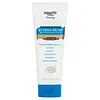What's inside
What's inside
 Key Ingredients
Key Ingredients

 Benefits
Benefits

 Concerns
Concerns

No concerns
 Ingredients Side-by-side
Ingredients Side-by-side

Colloidal Oatmeal 1%
AbsorbentWater
Skin ConditioningGlycerin
HumectantRicinus Communis Seed Oil
MaskingParaffinum Liquidum
EmollientCetyl Alcohol
EmollientGlyceryl Stearate
EmollientCaprylic/Capric Triglyceride
MaskingOctyldodecanol
EmollientCetyl Palmitate
EmollientPEG-40 Stearate
EmulsifyingGlycyrrhiza Inflata Root Extract
Skin ConditioningCeramide NP
Skin Conditioning1,2-Hexanediol
Skin ConditioningPhenoxyethanol
PreservativePiroctone Olamine
PreservativeCaprylyl Glycol
EmollientEthylhexylglycerin
Skin ConditioningBenzyl Alcohol
PerfumingCitric Acid
BufferingColloidal Oatmeal 1%, Water, Glycerin, Ricinus Communis Seed Oil, Paraffinum Liquidum, Cetyl Alcohol, Glyceryl Stearate, Caprylic/Capric Triglyceride, Octyldodecanol, Cetyl Palmitate, PEG-40 Stearate, Glycyrrhiza Inflata Root Extract, Ceramide NP, 1,2-Hexanediol, Phenoxyethanol, Piroctone Olamine, Caprylyl Glycol, Ethylhexylglycerin, Benzyl Alcohol, Citric Acid
Colloidal Oatmeal 2%
AbsorbentWater
Skin ConditioningGlycerin
HumectantPropanediol
SolventDimethicone
EmollientPetrolatum
EmollientGlyceryl Stearate
EmollientCetyl Alcohol
EmollientAloe Barbadensis Leaf Juice
Skin ConditioningJojoba Esters
EmollientPolyacrylate-13
Polyisobutene
Polysorbate 20
EmulsifyingButyrospermum Parkii Butter Extract
Skin ConditioningAvena Sativa Kernel Extract
AbrasiveBisabolol
MaskingZingiber Officinale Root Extract
MaskingC10-30 Cholesterol/Lanosterol Esters
EmulsifyingCeramide Ng
Skin ConditioningHydrolyzed Jojoba Esters
Skin ConditioningTocopheryl Acetate
AntioxidantMagnesium Ascorbyl Phosphate
AntioxidantPanthenol
Skin ConditioningEthylhexylglycerin
Skin ConditioningC12-15 Alkyl Benzoate
AntimicrobialTribehenin
EmollientLactic Acid
BufferingDisodium EDTA
Phenoxyethanol
PreservativeHippophae Rhamnoides Oil
EmollientPEG-10 Phytosterol
EmulsifyingPalmitoyl Hexapeptide-12
Skin ConditioningColloidal Oatmeal 2%, Water, Glycerin, Propanediol, Dimethicone, Petrolatum, Glyceryl Stearate, Cetyl Alcohol, Aloe Barbadensis Leaf Juice, Jojoba Esters, Polyacrylate-13, Polyisobutene, Polysorbate 20, Butyrospermum Parkii Butter Extract, Avena Sativa Kernel Extract, Bisabolol, Zingiber Officinale Root Extract, C10-30 Cholesterol/Lanosterol Esters, Ceramide Ng, Hydrolyzed Jojoba Esters, Tocopheryl Acetate, Magnesium Ascorbyl Phosphate, Panthenol, Ethylhexylglycerin, C12-15 Alkyl Benzoate, Tribehenin, Lactic Acid, Disodium EDTA, Phenoxyethanol, Hippophae Rhamnoides Oil, PEG-10 Phytosterol, Palmitoyl Hexapeptide-12
 Reviews
Reviews

Ingredients Explained
These ingredients are found in both products.
Ingredients higher up in an ingredient list are typically present in a larger amount.
Cetyl Alcohol is a fatty alcohol. Fatty Alcohols are most often used as an emollient or to thicken a product.
Its main roles are:
Though it has "alcohol" in the name, it is not related to denatured alcohol or ethyl alcohol.
The FDA allows products labeled "alcohol-free" to have fatty alcohols.
Learn more about Cetyl AlcoholAccording to INCI standards, this ingredient refers to the physical ground up oatmeal. If you are looking for colloidal oatmeal in skincare, you'll most likely see Avena Sativa Kernel Extract on your ingredient list.
Physical colloidal oatmeal is an abrasive meaning it provides physical exfoliation.
Ethylhexylglycerin (we can't pronounce this either) is commonly used as a preservative and skin softener. It is derived from glyceryl.
You might see Ethylhexylglycerin often paired with other preservatives such as phenoxyethanol. Ethylhexylglycerin has been found to increase the effectiveness of these other preservatives.
Glycerin is already naturally found in your skin. It helps moisturize and protect your skin.
A study from 2016 found glycerin to be more effective as a humectant than AHAs and hyaluronic acid.
As a humectant, it helps the skin stay hydrated by pulling moisture to your skin. The low molecular weight of glycerin allows it to pull moisture into the deeper layers of your skin.
Hydrated skin improves your skin barrier; Your skin barrier helps protect against irritants and bacteria.
Glycerin has also been found to have antimicrobial and antiviral properties. Due to these properties, glycerin is often used in wound and burn treatments.
In cosmetics, glycerin is usually derived from plants such as soybean or palm. However, it can also be sourced from animals, such as tallow or animal fat.
This ingredient is organic, colorless, odorless, and non-toxic.
Glycerin is the name for this ingredient in American English. British English uses Glycerol/Glycerine.
Learn more about GlycerinGlyceryl Stearate is a mix of glycerin and stearic acid.
It is used to stabilize the mixing of water and oil ingredients. By preventing these ingredients from separating, it can help elongate shelf life. It can also help thicken the product's texture.
As an emollient, it helps soften skin and supports barrier-replenishing ingredients.
In cosmetics, Glyceryl Stearate is often made from vegetable oils or synthetically produced.
This ingredient may not be fungal-acne safe
Fun fact: The human body also creates Glyceryl Stearate naturally.
Learn more about Glyceryl StearatePhenoxyethanol is a preservative that has germicide, antimicrobial, and aromatic properties. Studies show that phenoxyethanol can prevent microbial growth. By itself, it has a scent that is similar to that of a rose.
It's often used in formulations along with Caprylyl Glycol to preserve the shelf life of products.
Water. It's the most common cosmetic ingredient of all. You'll usually see it at the top of ingredient lists, meaning that it makes up the largest part of the product.
So why is it so popular? Water most often acts as a solvent - this means that it helps dissolve other ingredients into the formulation.
You'll also recognize water as that liquid we all need to stay alive. If you see this, drink a glass of water. Stay hydrated!
Learn more about Water